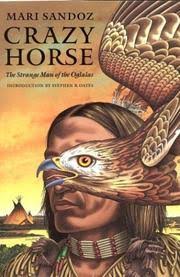Mari Sandoz, Crazy Horse: Man of the Sioux (1942)
GoodReads meta-data is 428 pages, rated as 4.26 by 1301 litizens.
Genre: Biography.
Verdict: Unique.
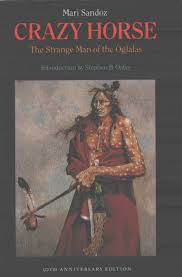
Crazy Horse (1840-1877) was born an odd man out in the Sandhill country of Nebraska. He was of fair hair and fair skin relative to his people. There is no reason to suppose any European connection in his gene pool, just an aberration like Peter the Great’s height. When he was teenager a European described him as an albino with red eyes. Set apart from birth by appearance he became moody teenage loner, often preferring his own company to that of his peers. Aloof, he played little role in the tribe, though his father and brothers were leaders.
There had long been a trickle of European immigrants travelling west on the Holy Trail in the Platte River Valley, but the trickle changed after 1865 in two ways: first, Europeans established ever more permanent settlements along the way. They were coming to stay. Second, after the end of Civil War the trickle became a flood. These changes coincided with Crazy Horse’s manhood.
There were many conflicts, first, with the traditional enemies the Crow, Pawnee, and Utes for hunting grounds and winter quarters; there were few with the immigrants who passed though but when the army began to build forts the conflicts with the immigrants and army increased. The linguistic and cultural barriers provided much room for misunderstanding and conflict, as did the sense of superiority held both by the Sioux and the Europeans. Each thought the other primitive.
Even in Crazy Horse’s youth the demographics were clear. There were many more white men than red men at any one place. But it is also true that the many Indians had no history of cooperation, and for a long time many of them still perceived other Indians as the real enemy, which was reinforced by cultural norms that praised horse theft, ambush of traditional rivals, and the like. There were no cultural values for dealing with the white man and his guns and cannons. In addition, the usual Indian methods of warfare emphasised the individual warrior and not teamwork, coordination, or planning. Ergo even within one tribe like the Ogalala Sioux there was neither experience nor cultural reward for teamwork, coordination, or planning. The impetuous hothead who struck out on his own was the ideal.
Add to that the temptation of demon whiskey and some tribesmen sold out others to get the burning cup.
But the capstone was gold in Black Hills. Once it was found the whites did not pass through or stay in the forts, but penetrated the hinterland and spread out to find and to mine gold, and the army followed to protect them. This exploration led, inevitably, to many conflicts and escalating violence. Once the Civil War ended many in the eastern and southern United States looked to the West for a new life, to forget the past and gold was magnet for them and those who would live off them selling coffee, shovels, and the like. The demand for protection from Indians increased exponentially as the white population increased.
Crazy Horse proved to be skilful warrior and had many successes. He was thus anointed as a shirt-wearer, or leading warrior, who embodied the tribe. Later he lost this honour in a quarrel over a woman. Sioux leaders were supposed to be above such personal concerns, think Philosopher Kings, and he lost the title, though he remained the best warrior.
There were peace-makers and peace-keepers, straight arrows, and negotiators among both the Red and White, but there were also self-serving scoundrels, liars, hotheads, and the greedy on both sides. The Indian social unit was a clan and any joint action with other Indians was difficult after years or rivalry, hostility, and worse. It is also true that in the army were many officers who had learned that the gun solved all problems. They applied the Appomattox solution of overwhelming force to the Indians. The irony is that many of the US troopers in the Indians Wars were veterans of the Confederate army who had nothing and no one to go home to and no other means of livelihood but soldiering. They were determined to be on the winning side this time.
The white buffalo was a rarity and when one appeared it was taken by the Sioux to be sign from the gods. That Crazy Horse was so pale associated him in the minds of many of the tribesmen with this holy sign. Moreover, he himself came to find several of the white buffalo which was remarkable. The white buffalo is not a sacred cow, but rather is killed and returned to the earth as an offering to the gods. It was rare for a warrior to kill one white buffalo when Crazy Horse had killed two. In this way he was further set apart from his fellows.
There were also other signs of charisma. He survived being shot in the face by a jealous rival when all thought he would die. He was indeed marked out. His successes attracted envy and the envious started rumours to blacken his name, but his persistent modesty and serenity were proof against these innuendoes.
The sad story ends when Crazy Horse surrendered to live on a reservation, but was killed. How and why he was murdered is unclear, but murdered he was at a fort while under the protection of the United States Army. No inquiry was held and no one held responsible. Sounds like something that could happen today.
This book is written from the Sioux point of view, using the idioms and references of the Lakota. One might almost might call it a fictional autobiography. At the end is long list of the individuals whom she interviewed, and the archives consulted. Sandoz grew up in the Sandhills among the Sioux and they were a lifetime preoccupation for her.
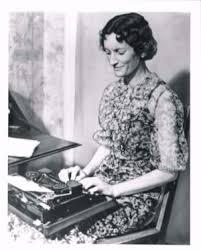
Following Charles van Doren’s advice from long ago, I usually skip the front matter of a book to read the book and make up my own mind, but for some reason I started to read introduction by the reprint series editor and found is self-deprecating, honest, devoid of clichés, self-promotion, and corporate-speak, and penetrating. I read it to the end, a rarity that.
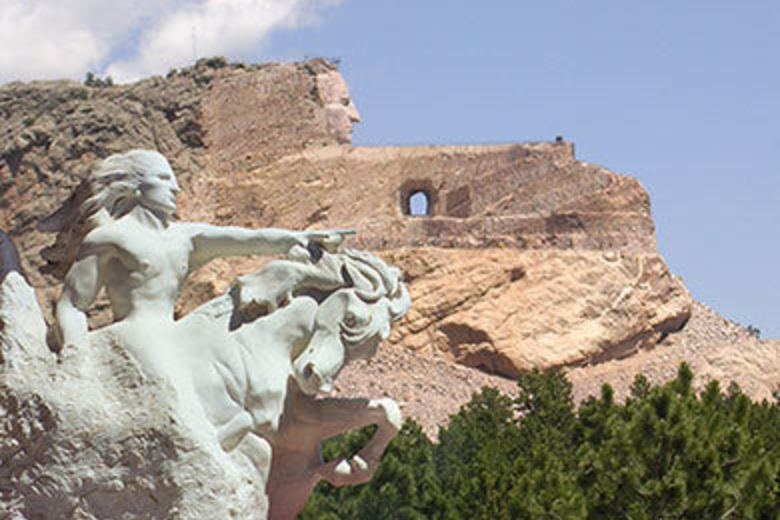
A decade ago or so we went to Mount Rushmore and saw the site of the Crazy Horse memorial. The mental note I made then to find out more about this legendary figure was redeemed with reading this book.
Crazy Horse echoes: An Excelsior class starship bears his name in StarTrek: The Next Generation.
Like an NBA shooting guard, a writer needs a short memory to forget the mistakes, errors, misses, and rejections. Sandoz once said she had had more than 7000 rejections for her short stories, novels, essays, and non-fiction. She was so depressed by word ‘No’ at one time that she burned a bathtub full of manuscripts. In the early years she made a living as a school teacher by day.
Sandoz’s first book was rejected by fourteen major publishers before it won a prize sponsored by a magazine for a new writer’s first book. That was Old Jules (1935), followed by many others including Cheyenne Autumn (1953) and These were the Sioux (1961). The more she published about the treatment of Sioux the more persona non grata she became in Nebraska and she finally relocated to the East Coast to be near the publishers. Though now her likeness graces the state capital building in a hall of notables.
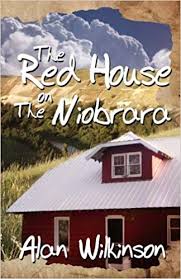
Alan Wilkinson’s Red House on the Niobrara (2012) is a tribute to Sandoz. It is discussed elsewhere on this blog.

